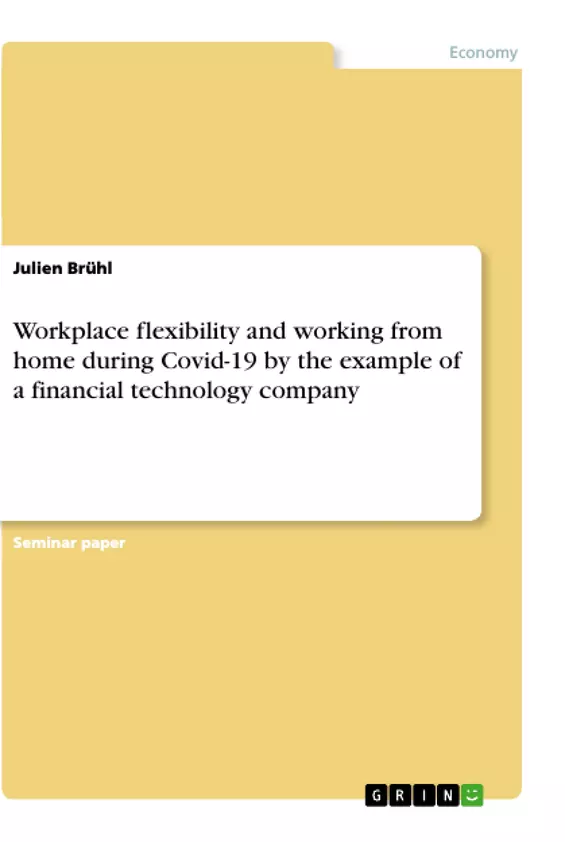How has workplace flexibility during the Covid-19 pandemic affected everyday working life and employee interrelations?
Through the use of qualitative semi-structured interviews, this paper aims to analyze and answer the effect of work-from-home on workplace flexibility, and whether the Covid-19 pandemic plays a role in this. Moreover, the paper aims to understand variables such as autonomy within the workplace, colleague dynamics, and identification with the organization.
“I like having the choice to [work from home], but I prefer the office.” Although this quotation portrays employees as viewing workplace flexibility in a positive way, this study has found that this is not always the case. Indeed, at the beginning of the Coronavirus-19 pandemic, the world came to a standstill, and humans experienced lockdowns and restrictions globally. This also included employees of organizations worldwide who were legally required to work from home (WFH) to help minimize the risk of infection between coworkers and in their home-life. With employees encouraged to WFH, their new work modes changed, from going to the office daily to working from home through various computer-mediated communication (CMC) resources, with Zoom, Slack, Microsoft Teams, to name a few. This increase in work-from-home during the pandemic has become the new norm around the world. With the introduction of CMC and an increase in workplace flexibility, such factors could influence how an employee feels about working from home, their identification with the company, their motivation, and whether this has an impact on their overall work performance.
Numerous academic papers studying the use of workplace flexibility in different workplace settings have been analyzed to understand whether tensions can arise through this method. In the current study, workplace flexibility is defined as the ability and possibility to decide where, when and how one works and encompasses how, as an employee, you are given the opportunity to decide on the time, location and task features of your work in order to create a balance between work- and home-life.
Inhaltsverzeichnis (Table of Contents)
- Introduction and problem definition
- Autonomy paradox
- Theory and literature
- Tensions around workplace flexibility
- Identification
Zielsetzung und Themenschwerpunkte (Objectives and Key Themes)
This study explores the impact of workplace flexibility, particularly working from home during the Covid-19 pandemic, on everyday working life and employee interrelations. It investigates how changes in work modes, facilitated by computer-mediated communication (CMC) and increased autonomy, have affected employee identification with their companies, motivation, and overall work performance.
- Workplace flexibility and its impact on everyday working life
- The influence of computer-mediated communication (CMC) on employee interactions
- The role of autonomy in work-life balance and employee commitment
- Employee identification with their organizations in a remote work context
- Tensions arising from opposing forces in work features (time, space, and tasks)
Zusammenfassung der Kapitel (Chapter Summaries)
- Introduction and problem definition: The study sets the stage by outlining the emergence of workplace flexibility during the Covid-19 pandemic, particularly the shift to working from home (WFH). It highlights the growing importance of understanding how this change impacts employee well-being, motivation, and identification with their organizations.
- Autonomy paradox: The study explores the concept of the autonomy paradox, drawing on existing literature. This paradox refers to the potential tension between increased autonomy, afforded by technology, and the potential for increased social control and overcommitment. The authors suggest that working from home during the pandemic could exacerbate this paradox, with individuals potentially experiencing a sense of both freedom and restriction.
- Tensions around workplace flexibility: The study examines the potential for tensions around workplace flexibility, drawing on the work of Putnam et al. (2014). They argue that flexible work arrangements can create tensions between variable and fixed arrangements, and between supportive and unsupportive work environments. The authors suggest that these tensions can be exacerbated in a remote work context, where personal interaction is limited and communication can be more challenging.
- Identification: The study focuses on the concept of identification, highlighting its importance in understanding employee behavior and motivation. They argue that changes in work modes, particularly working from home, can influence employee identification with their organizations, potentially impacting their work performance and commitment.
Schlüsselwörter (Keywords)
Workplace flexibility, working from home, Covid-19, computer-mediated communication (CMC), autonomy, identification, employee interrelations, autonomy paradox, tensions, flexible work arrangements.
- Quote paper
- Julien Brühl (Author), 2021, Workplace flexibility and working from home during Covid-19 by the example of a financial technology company, Munich, GRIN Verlag, https://www.grin.com/document/1174220



